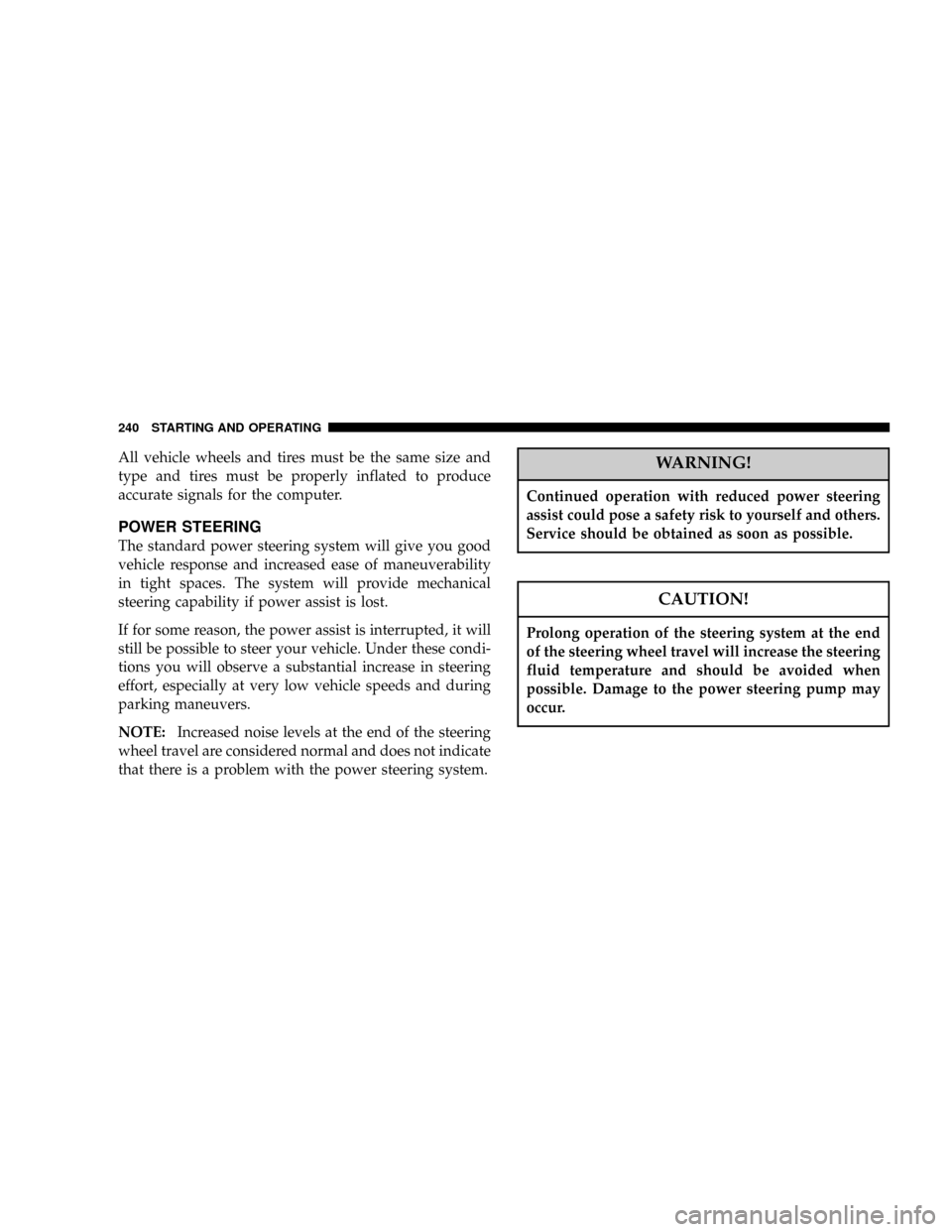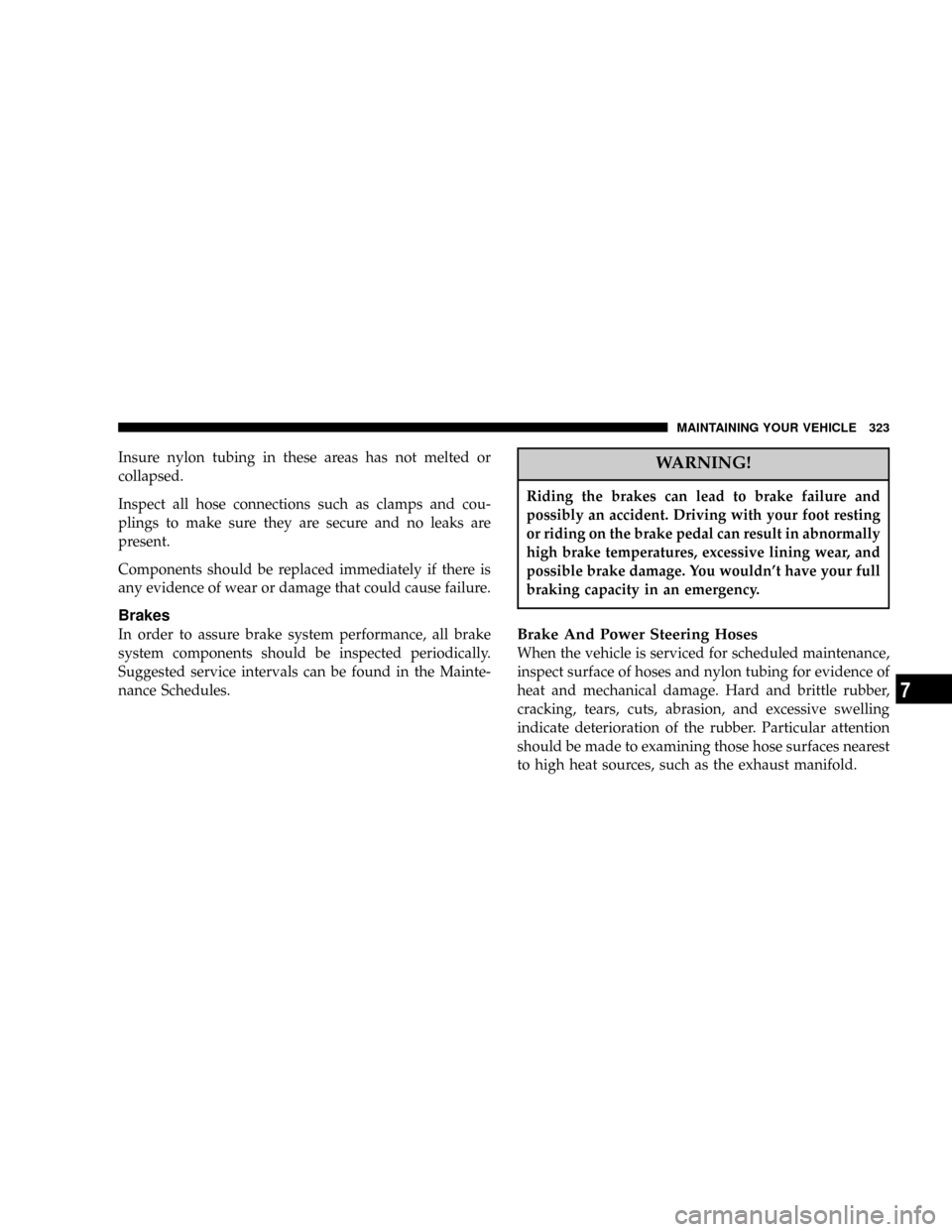power steering DODGE CARAVAN 2004 4.G Owners Manual
[x] Cancel search | Manufacturer: DODGE, Model Year: 2004, Model line: CARAVAN, Model: DODGE CARAVAN 2004 4.GPages: 397, PDF Size: 6.83 MB
Page 72 of 397

Airbag Light
The light should come on and remain on for 6 to 8
seconds as a bulb check when the ignition switch is first
turned ON. If the LED is not lit during starting, have it
checked. If the light stays on or comes on while driving,
have the system checked by an authorized dealer.
Defroster
Check operation by selecting the defrost mode and place
the blower control on high speed. You should be able to
feel the air directed against the windshield.
Periodic Safety Checks You Should Make Outside
The Vehicle
Tires
Examine tires for excessive tread wear or uneven wear
patterns. Check for stones, nails, glass, or other objects
lodged in the tread. Inspect tread and sidewall for cuts or
cracks. Check wheel nuts for tightness, and tires (includ-
ing spare) for proper pressure.
Lights
Have someone observe the operation of exterior lights
while you work the controls. Check turn signal and high
beam indicator lights on the instrument panel.
Fluid Leaks
Check area under vehicle after overnight parking for fuel,
engine coolant, oil or other fluid leaks. Also, if gasoline
fumes are detected or fuel, power steering fluid or brake
fluid leaks are suspected, the cause should be located and
corrected immediately.
72 THINGS TO KNOW BEFORE STARTING YOUR VEHICLE
Page 79 of 397

WARNING!
Vehicles and other objects seen in the right side
convex mirror will look smaller and farther away
than they really are. Relying too much on your right
side mirror could cause you to collide with another
vehicle or other object.
Use your inside mirror when judging the size or
distance of a vehicle seen in this convex mirror.
Power Remote-Control Mirrors Ð If Equipped
Use the mirror select switch, located on the instrument
panel to the left of the steering column, to adjust the view
obtained in the outside mirrors. Press the rocker switch to
the L or R for Left or Right mirror selection. Use the
center off position to guard against accidentally moving
a mirror position.Select a mirror and press one of the four arrows for the
direction you want the mirror to move.
UNDERSTANDING THE FEATURES OF YOUR VEHICLE 79
3
Page 161 of 397

AM Reception
AM sound is based on wave amplitude, so AM reception
can be disrupted by such things as lightning, power lines
and neon signs.
FM Reception
Because FM transmission is based on frequency varia-
tions, interference that consists of amplitude variations
can be filtered out, leaving the reception relatively clear,
which is the major feature of FM radio.
NOTE:On vehicles so equipped the radio, steering
wheel radio controls and 6 disc CD/DVD changer if
equipped, will remain active for up to 45 seconds after
the ignition switch has been turned off. Opening a
vehicle front door will cancel this feature.
SALES CODE RAZÐAM/ FM STEREO RADIO
WITH CASSETTE TAPE PLAYER, CD PLAYER
AND CD CHANGER CONTROLS Ð IF EQUIPPED
Operating Instructions Ð Radio
NOTE:Power to operate the radio is controlled by the
ignition switch. It must be in the ON or ACC position to
operate the radio.
UNDERSTANDING YOUR INSTRUMENT PANEL 161
4
Page 195 of 397

NOTE:Follow the manufactures instructions for the
correct colors when connecting the RCA cables.
Operating Instructions Ð Video
Games/Camcorders
A video game unit or camcorder can be connected to the
rear audio/video system. Connect the cables to the RCA
jacks located on the front of the CD/DVD changer.
NOTE:To operate a video game unit a DC to AC
adapter may be required, plug the adapter into any
power outlet.
Follow the manufactures instructions for the correct
colors when connecting the RCA cables.
NOTE:MP3 player's, video game systems, camcorders
connected to the RCA jacks and CD's or DVD's inserted
into the CD/DVD changer can be heard through the
headphones.
REMOTE SOUND SYSTEM CONTROLS Ð IF
EQUIPPED
The remote sound system controls are located on the rear
surface of the steering wheel at the 3 and 9 O'clock
positions.
The right hand rocker switch has a push button in the
center and controls the volume and mode of the sound
UNDERSTANDING YOUR INSTRUMENT PANEL 195
4
Page 223 of 397

STARTING AND OPERATING
CONTENTS
mStarting Procedures.....................226
N2.4L Engine.........................226
N3.3L And 3.8L Engine..................228
mEngine Block Heater Ð If Equipped.........230
mAutomatic Transmission..................231
NBrake/Transmission Interlock System.......232
NAutomatic Transmission Ignition Interlock
System.............................232
NFour Speed Automatic Transmission........232mAll Wheel Drive Ð If Equipped............235
mParking Brake.........................235
mBrake System..........................237
NAnti-Lock Brake System Ð If Equipped.....237
mPower Steering........................240
mTraction Control Ð If Equipped............241
mTire Safety Information...................242
NTire Markings........................242
NTire Identification Number (TIN)..........246
5
Page 240 of 397

All vehicle wheels and tires must be the same size and
type and tires must be properly inflated to produce
accurate signals for the computer.
POWER STEERING
The standard power steering system will give you good
vehicle response and increased ease of maneuverability
in tight spaces. The system will provide mechanical
steering capability if power assist is lost.
If for some reason, the power assist is interrupted, it will
still be possible to steer your vehicle. Under these condi-
tions you will observe a substantial increase in steering
effort, especially at very low vehicle speeds and during
parking maneuvers.
NOTE:Increased noise levels at the end of the steering
wheel travel are considered normal and does not indicate
that there is a problem with the power steering system.
WARNING!
Continued operation with reduced power steering
assist could pose a safety risk to yourself and others.
Service should be obtained as soon as possible.
CAUTION!
Prolong operation of the steering system at the end
of the steering wheel travel will increase the steering
fluid temperature and should be avoided when
possible. Damage to the power steering pump may
occur.
240 STARTING AND OPERATING
Page 295 of 397

MAINTAINING YOUR VEHICLE
CONTENTS
m2.4L Engine...........................298
m3.3L/3.8L Engines......................299
mOnboard Diagnostic System Ð OBD II........300
mEmissions Inspection And Maintenance
Programs............................301
mReplacement Parts......................302
mDealer Service.........................302
mMaintenance Procedures..................303
NEngine Oil..........................303NEngine Oil Filter......................307
NDrive Belts Ð Check Condition And Tension . . 307
NSpark Plugs.........................308
NEngine Air Cleaner Filter................308
NEngine Fuel Filter.....................309
NCatalytic Converter....................309
NMaintenance-Free Battery................311
NAir Conditioner......................312
NPower Steering Ð Fluid Check............314
7
Page 296 of 397

NFront Suspension Ball Joints..............314
NSteering Shaft Seal....................314
NSteering Linkage......................315
NDrive Shaft Universal Joints..............315
NBody Lubrication.....................315
NWindshield Wiper Blades................316
NWindshield And Rear Window Washers.....316
NExhaust System......................317
NCooling System.......................318
NHoses And Vacuum/Vapor Harnesses.......322
NBrakes.............................323
NMaster Cylinder Ð ABS Brakes Brake Fluid
Level Check.........................324NFuel System Hoses....................326
NAutomatic Transmission................326
NAll Wheel Drive (AWD).................329
NFront And Rear Wheel Bearings...........330
NAppearance Care And Protection From
Corrosion...........................330
NCleaning The Instrument Panel And
Underseat Cup Holders.................334
mIntegrated Power Module (IPM)............336
mVehicle Storage........................337
mReplacement Light Bulbs.................338
mBulb Replacement......................339
NHeadlights..........................339
296 MAINTAINING YOUR VEHICLE
Page 314 of 397

Power Steering Ð Fluid Check
Checking the power steering fluid level at a defined
service interval is not required. The fluid should only be
checked if a leak is suspected, abnormal noises are
apparent, and/or the system is not functioning as antici-
pated. Coordinate inspection efforts through a certified
DaimlerChrysler Dealership.9
WARNING!
Fluid level should be checked on a level surface and
with the engine off to prevent injury from moving
parts and to insure accurate fluid level reading. Do
not overfill. Use only manufacturers recommended
power steering fluid.
If necessary, add fluid to restore to the proper indicated
level. With a clean cloth, wipe any spilled fluid from all
surfaces. Refer to Recommended Fluids, Lubricants, and
Genuine Parts for correct fluid type.
Front Suspension Ball Joints
The front suspension ball joints are permanently sealed.
No regular maintenance is required for these compo-
nents.
Steering Shaft Seal
The steering shaft seal, at the point where the shaft passes
through the bulkhead, is lubricated when it is installed. If
the seal becomes noisy when the steering shaft is turned,
it should be lubricated. Use only manufacturers recom-
mended lubricant, refer to Recommended Fluids, Lubri-
cants and Genuine Parts for correct lubricant type.
314 MAINTAINING YOUR VEHICLE
Page 323 of 397

Insure nylon tubing in these areas has not melted or
collapsed.
Inspect all hose connections such as clamps and cou-
plings to make sure they are secure and no leaks are
present.
Components should be replaced immediately if there is
any evidence of wear or damage that could cause failure.
Brakes
In order to assure brake system performance, all brake
system components should be inspected periodically.
Suggested service intervals can be found in the Mainte-
nance Schedules.
WARNING!
Riding the brakes can lead to brake failure and
possibly an accident. Driving with your foot resting
or riding on the brake pedal can result in abnormally
high brake temperatures, excessive lining wear, and
possible brake damage. You wouldn't have your full
braking capacity in an emergency.
Brake And Power Steering Hoses
When the vehicle is serviced for scheduled maintenance,
inspect surface of hoses and nylon tubing for evidence of
heat and mechanical damage. Hard and brittle rubber,
cracking, tears, cuts, abrasion, and excessive swelling
indicate deterioration of the rubber. Particular attention
should be made to examining those hose surfaces nearest
to high heat sources, such as the exhaust manifold.
MAINTAINING YOUR VEHICLE 323
7